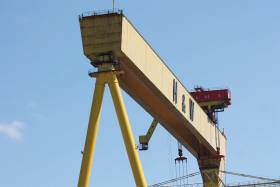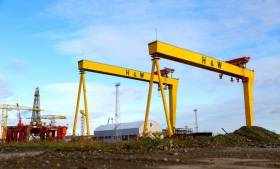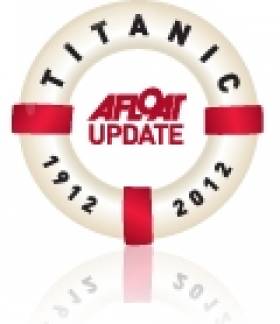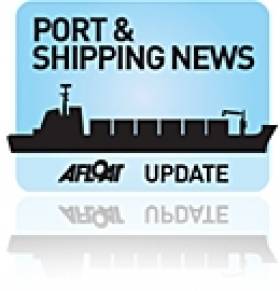Displaying items by tag: Harland and Wolff
Harland and Wolff’s Norwegian majority owner has announced it will file for bankruptcy — but the Belfast shipyard says business will continue as usual, as the Belfast Telegraph reports.
The move comes after Dolphin Drilling ASA, formerly Fred Olsen Energy, says it failed to reach a deal with its creditors.
Harland and Wolff, which in recent years has diversified from shipbuilding to the renewable energy sector, is expected to be sold this year as part of its parent company’s restructuring plan.
A spokesperson for Harland and Wolff Heavy Industries Ltd said: “The announced developments in relation to DDASA are not expected to impact this sales process and we are operating very much on a business as usual basis.”
The Belfast Telegraph has more on the story HERE.
Scottish Firm Seeks New Funding For Belfast-Built Tidal Turbine
#SeaPower - A Scottish tidal energy company is launching a new round of funding to commericalise its developments in Orkney, as HydroWorld reports.
Scotrenewables has appointed Aberdeen-based financial advisors Simmons & Company International to lead the investment process after successful testing over the last year of its SR2000 2MW floating turbine, built at Harland and Wolff in Belfast.
The grid-connected device has reportedly supplied up to 25% of Orkney’s power demands at times, with recent figures hitting 20MWh per day. HydroWorld has much more HERE.
#H&W - Harland and Wolff, Belfast faces a tough year ahead having failed to secure a "sufficient workload" as the latest accounts shows a big drop in profits for 2015.
The Belfast Telegraph writes that the firm generated operating profit of £1m for the year ending December 2015, according to the latest accounts for Harland & Wolff Heavy Industries Ltd.
That was down from £8.6m a year earlier, however, turnover rose to £66.7m from £55.2m.
It says the directors consider the "results for the year are reflective of the difficult market conditions".
For more click here
Titanic Drawing Offices To Be Restored As Luxury Hotel
#Titanic - The drawing offices where the Titanic was designed could soon become a four-star hotel for Belfast's historic quarter.
According to The Irish Times, the British Heritage Lottery Fund has provided a grant of almost £5 million (€6.6m) to convert the former Harland and Wolff headquarters into 84 rooms of boutique accommodation.
And while no hotel group has as yet confirmed plans to take over the historic site at the Titanic Quarter, it's believed that the restoration funding will make the investment "much more commercially attractive".
The Titanic was not the only famous vessel to get its start at the H&W drawing offices – her sister ships the Olympic and Brittanic were also designed there, as was the warship HMS Belfast, now docked as a floating museum in London, and more than 1,000 other vessels.
The Irish Times has more on the story HERE.
Belfast Giants: Another Rig Is Just Here for Parking
#BelfastGiants - Belfast City residents and those living alongside the lough may have noticed a new hulk which sailed into the city recently, reports the News Letter.
A large oil rig, called the Borgny Dolphin, has docked at Harland and Wolff (H&W).
It comes just months after the leviathan-sized Blackford Dolphin which was reported on Afloat.ie, sailed out of the harbour, after many months of valuable re-fit work at the ship repair yard.
However, at the moment the H&W is not planning to do any work on the new arrival.
Instead it is simply laid up after its contract in the North Sea finished – effectively using H&W as a giant parking space while its operators figure out what to do with her next.
It could be months before a decision is made, said the firm.
H&W Prepares to Say Farewell to Giant Oil Platform
#GiantOilRig- Work is now nearing completion at Harland & Wolff which has been carrying out specialised emergency work on one of the world's biggest oil platforms, the Irish News has confirmed.
Depending on the tides in Belfast lough, the 360-foot Blackford Dolphin oil drilling rig - which as previously reported on Afloat.ie, has been in dry dock on Queen's Island since before Christmas - will finally head for home in Norway.
The multi-million-dollar renovation project on the rig, a vast industrial behemoth which has dominated the titanic Quarter skyline for months, was meant to take just 60 days. For more on the story click here.
Harland and Wolff Samson Gantry Breaks World Record
#SamsonsWorldRecord - The Belfast Telegraph reports that Harland and Wolff has broken a world record at the Belfast shipyard - by performing the world's heaviest single point WaterLoad test
As previously reported on Afloat.ie, the massive Samson gantry which was cast in pink lights during the prestigious Giro d'Italia, lifted an incredible 774 tonne load to certify Harland and Wolff's latest spreader beam arrangement.
The spreader beam has been a strategic investment to support the company's handling capability for large offshore structures such as jackets and offshore modules.
The load test bags were provided by Unique Seaflex, who are specialists in marine air lift buoyancy bags and water load test weights.
They provided 24 bags of various capacities which, when filled with water, provided the total load of 766 tonne - which is the world's heaviest single point WaterLoad test.
For more including video footage of the the World's biggest single point waterload 'big-lift', click here.
Giant 'Dolphin' Oil Rig Not Leaving Ulster Just Yet
#OilRig – The Newsletter reports that the industrial behemoth that is an oil rig at Harland & Wolff, is set to remain as part of the skyline of Belfast for a number of weeks to come.
As previously reported on Afloat.ie, the enormous Blackford Dolphin drilling rig which made its way from Brazil last year, is currently in dry dock at Harland and Wolff as part of a re-fit project involving more than 1,000 workers.
The original contract to complete the work began last year and had run its course by around mid-February. However, she is still in the yard, and likely to stay put for at least another month. To know why, the Newsletter has more on this story.
Harland & Wolff to Refit Huge Oil Rig is a Christmas Bonus
#Harland&Wolff – Harland & Wolff's landmark iconic cranes are to be relocated due to the refit of a massive oil rig which will act as the city's unofficial Christmas tree, bedecked with lights, as it towers over the harbour estate in a repair deal worth tens of millions of pounds.
The mammoth Blackford Dolphin oil drilling rig, originally built in 1974 in Norway, will be upgraded and repaired in the firm's 556m x 93m main building dock, starting in November for approximately 50 days.
The Aker H-3 rig underwent a major upgrade from 2006 to 2008, when Harland & Wolff designed and built accommodation blocks, power generation module, mud room and additional buoyancy.
For more on this story The Belfast Telegraph reports.
Ports & Shipping Review. Cargoships, WFSVs, Cork Ferry, IMERC, Dutch Navy & Last H&W Ferry Sold
#PORTS & SHIPPING REVIEW - Over the last fortnight Jehan Ashmore reports from the shipping scene which saw a 'Pop-Up Village' delivered by cargoship to Galway Port in readiness for the Volvo Ocean Race festival which started yesterday and continues to 8 July.
Arklow Marine Services second wind-farm support vessel (WFSV) Gardian 10 was launched for UK owners and today the vessel travelled from Arklow to Belfast Port and berthed at the Abercorn Basin.
In the rebel county, efforts to revive the Cork-Swansea route took a new step when a group was formed to ascess the feasibility in re-launching the Celtic Sea link that closed last November after Fastnet Line went into examinership.
At the Taoiseach's Public Service Excellence Awards, the Irish Maritime Energy Research Centre (IMERC) based in Haulbowline, Cork Harbour, won an award which was presented by Minister for Justice Alan Shatter T.D. at a ceremony held in Dublin Castle.
Across the world the International Maritime Organisation (IMO) highlighted the Day of the Seafarer on 25 June, where the role of those who work on ships provide a vital service in transporting essential goods on a global scale to meet our needs on a daily basis.
Dublin Port welcomed a flotilla from the Royal Netherlands Navy this weekend, where two of the vessels including a torpedo-training ship HNMLS Mercuur (A 900) was open to the public.
Today the cruiseship Saga Sapphire made her maiden 'Irish' port of call to Cobh having entered service in March for UK based operator Saga Cruises. The 706-passenger capacity ship is due to dock at Dublin Port tomorrow morning.
Former North Channel ferry stalwart Stena Caledonia which operated on the Larne/Belfast-Stranraer routes since 1990 has been sold by Stena Line to ASDP Ferry of Indonesia. She is the last ever passenger ship to have been built by Harland & Wolff shipyard in Belfast.






































































